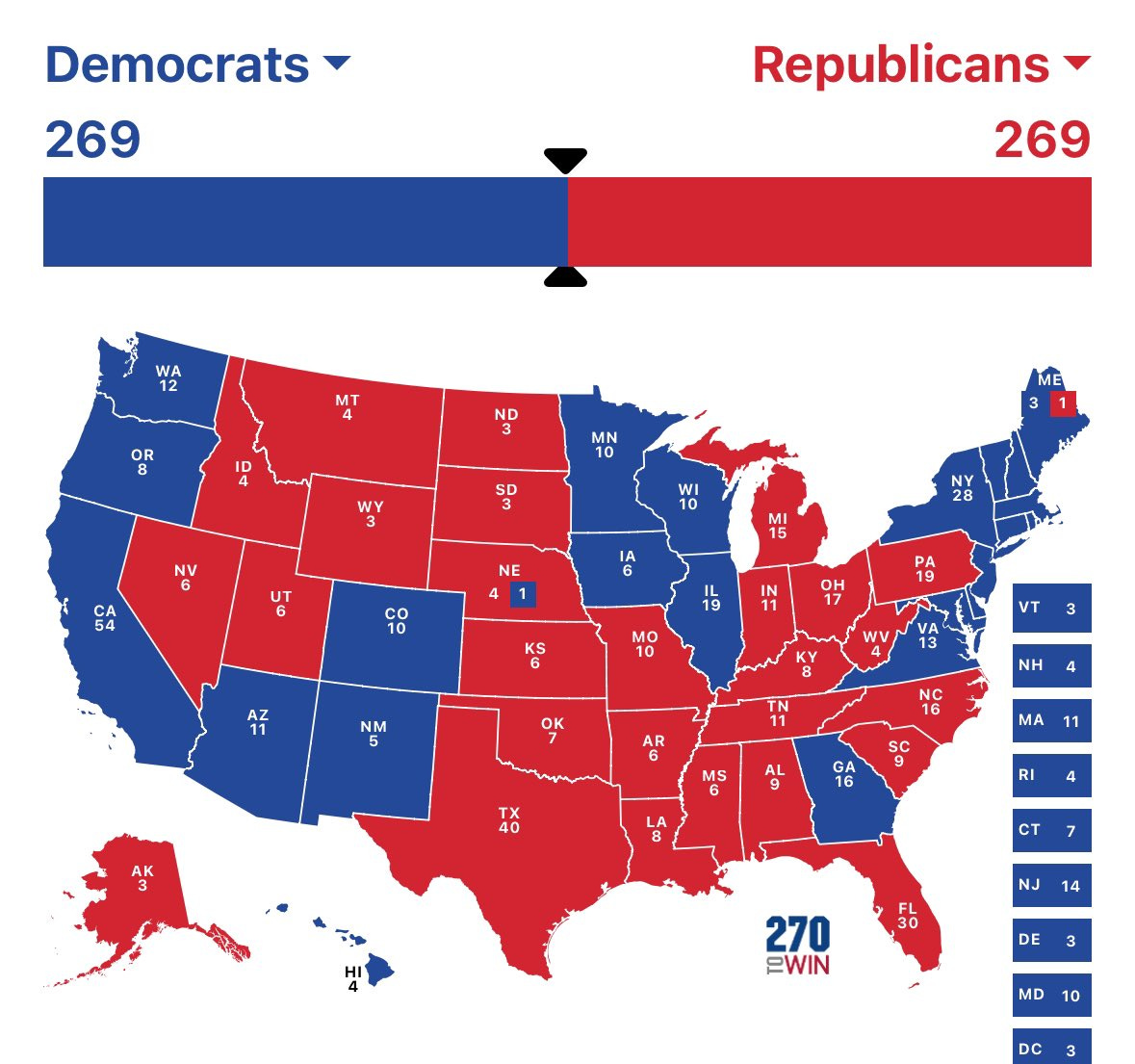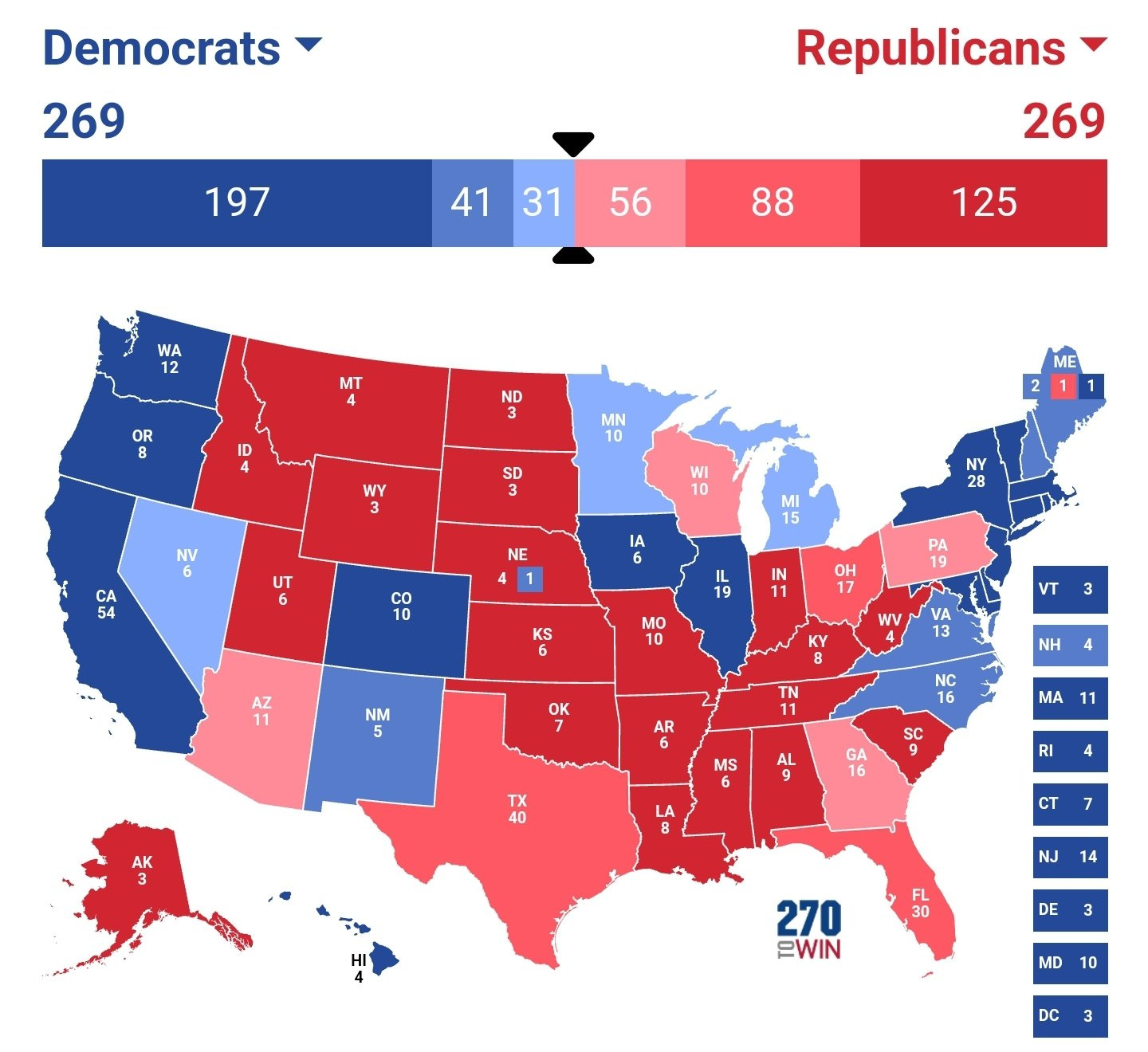November 5, 2024 — Imagine Election Day ends with a scenario so politically explosive it makes Florida 2000 look like a school election: Donald Trump and Kamala Harris, each stuck at 269 electoral votes — a perfect tie. With no candidate reaching the 270 electoral votes required to clinch the presidency, the race would head straight into a rarely used and highly complicated procedure that could make the 2020 Capitol chaos seem tame.
Here’s how it would go down — and why it could get messy.
Step 1: Electoral College Deadlock
The first step is recognizing that the Electoral College, established by the Constitution, requires a majority of at least 270 votes out of 538 to declare a president. In this hypothetical nail-biter, Trump and Harris have each won precisely half of those votes, leaving the country on the edge of a major constitutional procedure. With this 269-269 tie, the choice of president moves away from the voters and the Electoral College and lands right in the lap of the newly-elected Congress.
Step 2: The House Votes for President
According to the 12th Amendment, if no candidate receives a majority of electoral votes, the U.S. House of Representatives gets the duty of selecting the president. But it’s not as simple as a straight up-and-down vote among all House members. Instead, each state’s delegation gets one vote, regardless of the number of representatives that state has. So California, with its 52 representatives, has the same weight as Wyoming, which has only one.
The catch? To win, a candidate needs an absolute majority — at least 26 out of 50 state votes. With a Republican-dominated House, Trump would likely be favored in this scenario, as Republicans control more individual state delegations even if they hold fewer total seats than Democrats in the House.
This state-by-state vote, however, can’t happen until the newly elected House members are sworn in. That means the outcome hinges not only on the presidential election but also on the results of the House races, adding another level of suspense.
(Polls currently show that control of the House favors Republicans but only by about a handful of seats; a Democrat victory here is possible)
Step 3: The Senate Chooses the Vice President
While the House decides the president, the Senate decides the vice president. Here, things get even more interesting. Under the 12th Amendment, each senator has one vote, and the candidate who wins a simple majority becomes the next vice president. The Senate vote would likely come down to the makeup of the Senate following the election.
If Republicans take control, they could confirm a Republican vice president. If Democrats hold the Senate, Harris has a good chance of securing Tim Walz as vice president.
But what if the Senate is split 50-50? In that case, the sitting vice president — currently Harris — would cast the tie-breaking vote. That could theoretically allow her to make Minnesota Gov. Tim Walz Vice President, even if she fails to win the presidency.
Current polling shows the Republicans will likely capture 53 Senate seats.
(READ MORE Battleground State Senate Primer: What the Polls Say)
Step 4: The Potential for Political Gridlock
Let’s say the House votes in Trump as president, while the Senate votes in Walz as vice president.
The result? President Trump and Vice President Walz, a split in the presidential and vice presidential power dynamic not seen since the early Republican when the presidential runner-up used to become VP.
This would be a historic split in the executive branch, pitting the Republican and Democratic parties against each other in the highest offices.
Possible Challenges and Controversies
Should this process play out in January, it’s unlikely to be a smooth affair. Constitutional scholars point to several gray areas in this selection process that could lead to legal battles and political wrangling. For example, could the party in power in Congress delay the certification or even attempt to change certain procedural rules? Could lawsuits from disgruntled representatives further delay the outcome?
And let’s not forget the public’s reaction. With political tensions at an all-time high, this deadlocked election could lead to mass protests and challenges from both sides, each claiming that their candidate was wrongfully denied victory.
What Happens If the House and Senate Can’t Decide?
In theory, Congress must settle the matter by January 20, the date set by the 20th Amendment for the president to be sworn in. But what happens if they can’t agree by that deadline? If neither a president nor a vice president is chosen by Inauguration Day, the Presidential Succession Act would kick in, and the Speaker of the House would assume the role of acting president. This would mean that Republican Speaker Mike Johnson (if he remains in office) could take over temporarily, assuming Congress deadlocks.
Such a scenario could plunge the country into an even deeper constitutional crisis, as the speaker would serve only until a president is selected or until a deadlock is broken.
Is It Possible?
Here are three scenarios where it could happen, as reported by The New York Post
"Trump wins every state he captured in 2020, plus Michigan, Nevada, Pennsylvania and Wisconsin. Harris wins every state Joe Biden won in 2020, plus North Carolina.
Trump wins every state he won in 2020, plus Michigan and Pennsylvania, while Harris holds every other state Biden won in 2020.
Trump wins every state he won in 2020, plus Georgia, Michigan and Pennsylvania, while Harris wins every state Biden won in 2020 plus North Carolina.”
The super-simulator and calculator at 538 puts the odds of a tie or “no winner” are just 0.2%
This seems remote however, the maps that would create this scenario do not seem impossible. Here are what the maps would look like:
Looking Ahead
A 269-269 tie remains a long shot, but it’s not impossible — particularly if certain swing states turn out close, with both candidates winning a series of razor-thin victories.
With Election Day around the corner, one thing is clear: if Trump and Harris tie, it will take more than just a recount to settle. It will require navigating one of the most complicated and contentious constitutional processes in U.S. history, with all eyes on Capitol Hill and a divided nation watching every move.
Note from author: Like what you read? Share this article with a friend or subscribe using the buttons below now. Every subscription (even the free ones) or share helps support independent media in Texas and helps Cowtown Caller share its message with new audiences! *







